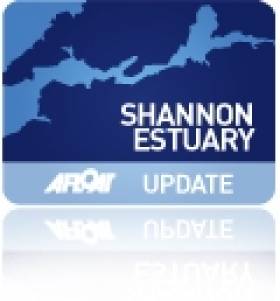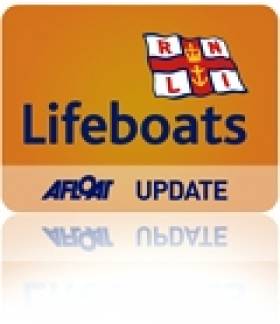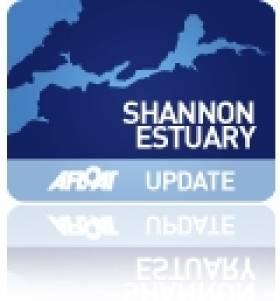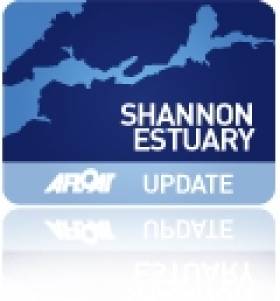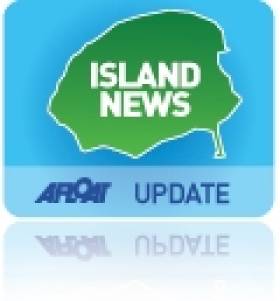Displaying items by tag: Shannon Estuary
New Maritime Museum in Foynes Officially Opened by Tourism Minister
#NEWmaritimeMuseum – Foynes Flying Boat & Maritime Museum welcomed Michael Ring TD, Minister of Tourism & Sport who officially opened yesterday the mid-west tourist attraction's new maritime museum.
Minister Ring said "This new Maritime Museum adds greatly to the overall Foynes Flying Boat Museum, and will attract repeat visitors as well as many maritime enthusiasts, keeping Foynes at the forefront of tourism in the Shannon Region and on the new Wild Atlantic Way.
"I am pleased that the Government, through Fáilte Ireland, has provided support to this very worthwhile project under the Tourism Capital Investment Programme.
"I know that the development of a Maritime Museum, that would tell the story of the River Shannon and the influence on the lives of those communities living nearby, has always been a goal of the Museum's management here at Foynes. This ambition has now been realised".
The new maritime section tells the story of one of Ireland's great maritime assets... the River Shannon. The exhibits on display detail the geology, personality and mythology of the estuary stretching from Limerick docks down to Loop Head, marking the mouth of the Shannon at its seaward limits.
As previously reported the diversity of topics on display in the new maritime museum is a combination of interactive technology, artefacts, replica exhibits, and a stunning view of Foynes from the recently reinstated control tower that was used for the trans-Atlantic flying boats.
The tower has a balcony (equipped with bino-cularscopes) where shipping activity can be directly observed from and inside the tower and from where there is a photo-montage outlining the various landmarks of the village and estuary.
The view overlooking Foynes includes Foynes Yacht Club, Foynes Island and in the far distance across the estuary is the Aughinish Alumina processing plant.
During yesterday's opening ceremony, the dry-bulker Foxtrot could be seen at a Port of Foynes berth directly opposite from the observation tower and where cargo was been loaded on board.
Shannon Foynes Port Company (SFPC) earlier this year launched the master plan vision to 2041, which looks forward to the future and the museum is doing its part to preserve the past for the future.
The new addition to the award-winning Flying Boat Museum completes the overall plan that was first envisaged back in 1987 when a small group of interested people got together to look at the possibility of establishing a Flying Boat Museum in the Co. Limerick village.
Failte Ireland partly funded the new museum under their National Development Plan 2007 – 2013 programme which in this phase totalled €1.5m in which 75% was funded from Failte Ireland. The remaining funding where met through the museum's own resources and with financial assistance from Limerick County & City Council.
This now brings the total investment in Foynes Museum to €4.5m over the past twenty five years. The centre supports 16 employees and this season has attracted 40,000 visitors. For the second time the museum has been given a Silver Award for best visitor attraction by CIE Tours in 2012.
This year the museum achieved a Certificate of Excellence from Tripadvisor and has featured in many TV holiday shows and documentaries both at home and overseas.
In 2014 the museum is to feature in BBC Getaways, the TV3 Documentary "The Island" and a documentary on Ireland's role in aviation to be screened on RTE and to go on general release.
Kilrush Lifeboat Assists More Drifting Boats In Shannon Estuary
#RNLI - There was another call-out for the Kilrush lifeboat to retrieve a boat broken free of its moorings on Tuesday 17 September, following Sunday's assist of a boat on the rocks at Mount Trenchard in the Shannon Estuary.
The volunteer crew of Kilrush RNLI launched quickly on Tuesday afternoon after a report that the boat was adrift off Glin in Co Limerick. Conditions on the day were very unfavourable with winds blowing south-westerly and gusting to Force 8.
The helm dropped one of the lifeboat crew at Glin Pier, where a number of locals brought him to the area where the boat was gone aground. Another crew member waded out to catch a tow line from the lifeboat, then proceeded to set up a long tow and was pulled to safer waters.
The lifeboat then made its way to Glin pier were the owner was located and the vessel was tied up securely.
But the Kilrush lifeboat wasn't finished its duties yet, as around 4.45pm the coastguard relayed a message reporting another small vessel gone aground at Hog Island, near Cappa Pier at Kilrush.
The crew quickly turned westwards toward this area where they found a sailing boat up on the rocks on the spit at Hog Island.
Again the speed of the crew proved invaluable as they transferred one of their crew onto the shore, where he quickly established a towline. The Kilrush crewman stayed on the vessel, communicating all the time with the lifeboat and the coastguard. Within five minutes the boat was tied up at Cappa Pier and safely secured.
Kilrush RNLI lifeboat press officer Pauline Dunleavy said: “It is at times like these that constant training pays off. The lifeboat crew braved the elements and brought a satisfactory outcome to the owners of these vessels.
"I would advise people to check that their mooring lines are strong and stable.”
Elsewhere, Crosshaven RNLI brought a troubled fishing boat with one person onboard to safety yesterday evening (18 September).
A mobile phone call to one of the Crosshaven RNLI crew members alerted them to a disabled fishing vessel seven miles south of Roches Point.
The pagers were activated and the volunteer crew of Kieran Coniry, Ian O'Keefe and Vincent Fleming launched to the aid of the stricken vessel at 4.45pm. With a north westerly Force Four wind and good conditions, the lifeboat made good progress and arrived a short time later.
The casualty vessel with one person on board had failed to restart its engine and was taken in tow by the lifeboat. The 37ft vessel was towed to Crosshaven Pier, arriving back at 7.30pm.
Foynes Yacht Club Promotes Sailing on Shannon Estuary
#foynes – On Saturday next the annual Glin Castle race will be sailed on the Shannon Estuary between the Royal Western Yacht Club in Kilrush and Foynes Yacht Club in Cooleen Point writes Gerry Ryan.
This particular race has been to the forefront in the annals of sailing on the river Shannon for a number of years now.
The late Knight of Glin, Desmond FitzGerald family are very much in favour of this event being held each year between the two yacht clubs.
The race is scheduled for 12 noon at Glin Pier, with a briefing at 11am, and it is proposed to sail down the estuary towards Moneypoint and back up the estuary to various club marks.
The event is open to Class 1, 2 and the Whte Sails division, where a total of 15 yachts will be racing in these three different classes.
After the racing a reception will be held in Glin Castle by Lady Olga FitzGerald and her family, where they will present the prizes to the various winners, and this will take place approximately at 5pm.
On Wednesday evening last a sponsors night was held in the clubhouse, who helped financially in any way with sailing events in the club over the last few years.
The evening started at 7pm with member's bringing the sponsors on different yachts for a sail around Foynes Island to view the Shannon Estuary from a different perspective.
Viewing the Tarbert power station towers down river and seeing the Clare coast as well a spectacle for the sponsors while some have never been sailing on the Shannon estuary before.
The giant alumina smelting plant, Aughinish Alumina can be seen with the very large structured sheds that store the alumina, and leaving the 'upper estuary' the view of Foynes Port comes into view, and the yacht club in glorious August sunshine.
When the sponsors arrived at the club they were treated to a wine and hors d'oeuvre reception, which were served by committee member, Patrica McCormack and Trish Lowes, with Shauna Kirwan looking after the bar.
Commodore Tom Murray in his address spoke about the 'voluntary effort that the member's have given the club since it's inception in 1962, and said that he was delighted that our sponsor's who we rely on support are extremely appreciated by the club.
He went on: 'What you see today is a fantastic facility for the community to enjoy, we have the facilities for the youth to learn sailing and become member's of this club, which is the backbone of every club'.
The annual Foynes to the Clare coastal village of Cappa race took place last Saturday in light conditions. A total of nine boats started at the club starting line with two divisions, Class 1 and 2 and White Sails.
The prizes were the Galleon Cup in the IRC handicap system and the Sean Keating trophy for the White Sails.
A total of five seconds in Class 1 and 2 separated Dexterity and Battle, which was closely fought by these two vessels,. and fifteen seconds between Golden Kopper and Dexterity on corrected time, but at the finish line at Cappa Pier, Golden Kopper received the Galleon Cup. After the IRC handicap only five minutes separated the boats.
In the White Sails division for the Sean Keating trophy former Commodore Pat Finucane and crew came first to the finish line.
At the presentation of prizes in the Galleon Inn, Class Captain, Alan McEneff thanked the proprietors for the display of food that they laid on for the hungry sailors, and also thanked Adrian O'Connell from the Royal Western Yacht Club, Kilrush for his organisation.
The September series of racing will be starting on Sunday, September 1 for the five Sunday's in the month. The series is for all classes, please check the website for starting times. All skippers are to ensure that any regular crew participating are fully paid up member's otherwise the vessel will not get a result or points for that race.Skippers are reminded that an entry fee will be due for the series. Member's are asked to be the marina at 1.30pm.
Club Polo shirts and Club burgees are for sale from the bar in the clubhouse.
Foynes Port Welcomes First Cruiseship Caller of the Season
#CruiseshipFoynes- Foynes Port today welcomed its first cruise-caller Prinsendam of the Holland America Line, writes Jehan Ashmore.
The 700 passenger vessel is on a 14-night cruise of British and Irish Ports having departed Amsterdam. Yesterday, the 38,848grt cruiseship had sailed overnight from an anchorage call off Galway Harbour.
One of the main visitor attractions is the Foynes Flying Boat Musuem. Earlier this year the visitor centre added a new Maritime Museum dedicated to the role of shipping between the Mouth of the Shannon and right up the estuary to Limerick Docks.
Originally, Voyages of Discovery's 15,396 tonnes Voyager was to be the first cruise caller to the estuary port. As previously reported, the ship had generator problems which prevented the vessel in making a call in late May.
Prinsendam is to depart this evening bound for Waterford Port. The next and only caller to Foynes this season is Pheonix Reisen's Amadea which is due in mid-September.
Foynes is one of six port facilities along the estuary operated by Shannon Foynes Port Company (SFPC) which posted a record operating profit of just over €3 million for 2012.
Shannon Foynes Posts Record Profits
#ShannonPortProfit – Record financial profits by Shannon Foynes Port Company (SFPC) is down to an increase in shipping activity levels not seen since 2008.
SFPC posted an operating profit of just over €3 million for 2012, which after financing costs and net disposal proceeds amounted to just over €2 million.
Operating profit represents a 6.6 per cent rise on 2011 performance. The Irish Times has more on this story.
Strange Case of Stranded Dolphin Found Two Miles Inland
#MarineWildlife - In a week that saw the Isle of Man's first sighting of a humpback whale for three years, BBC News reports on the strange discovery of a rare species of dolphin two miles inland from the shore in Co Donegal.
The carcass of an Atlantic white-sided dolphin was found on a hillside near Meenbanad with head injuries - but no one knows how it got there.
Pádraig Whooley of the Irish Whale and Dolphin Group (IWDG) said it's most likely that someone found the dead cetacean on the beach and took it to the hillside to decay so that its skeleton could later be retrieved.
The dolphin is thought to be one of a pod that beached at Traigheanna Bay in Dungloe on 21 June. The species is a rare sight in Irish coastal waters, said Whooley, because they tend to feed much further out at sea.
In other stranding news, the IWDG reports that a bottlenose dolphin who live stranded at Beal in Co Kerry last summer has been recorded in the Shannon Estuary with her calf on a number of occasions this month and last.
The Shannon Dolphin and Wildlife Foundation has more on the sightings of the dolphin they now call Sandy Salmon.
#medieval – Two medieval carvings that mysteriously went missing from Scattery Island in the Shannon Estuary more than 150 years ago have been located and are to be returned to the island as part of a Gathering event next month.
According to the Scattery Island Heritage & Tourism Group the stone artefacts were removed from the former monastic settlement in County Clare by a sea captain during the mid-19th century.
Their location was only identified earlier this year when the Group was contacted by a local family who had the artefacts for safekeeping (*see Notes to Editor) having discovered them more than 50 years ago.
The artefacts have been verified professionally and dated to the 12th and early 15th centuries by medieval stone carvings expert Jim Higgins (Heritage Officer for Galway City Council) and Dr Catherine Swift, Director of Irish Studies at Mary Immaculate College in Limerick.
Rita McCarthy of the Scattery Island Heritage & Tourism Group said the carvings will be returned to the island on July 7th as part of the Scattery Island Gathering.
She explained: "We are very grateful to local man Padraig de Barra, who for many years has held the artefacts for safekeeping and is keen to see them returned to Scattery Island. We understand that the Captain of the 'Erin Go Bragh' passenger ship, Francis Kennedy removed the artefacts from the island and used them as garden ornaments at his home in Cunningham Terrace in Kilkee. Sometime after his death in 1865 the artefacts were brought to St Senan's Well in Kilfeeragh where they remained until the 1960s whence they were discovered by Padraig. However, the stone carvings were never returned to the island due to concerns for their security."
Scattery Island, which has been uninhabited since 1979, is located approximately one mile from Kilrush in the Shannon Estuary and is home to a monastery founded in the early 6th century by St. Senan. The island features the ruins of six churches and one of the highest Round Towers in Ireland at 120 ft. high. The Vikings invaded Scattery during the early 9th century but Brian Boru later recaptured the island, which is also known as Inis Cathaigh. Scattery also served as a place of safe harbour for the Spanish Armada and as a defence outpost for the English Government.
Commenting in the upcoming Gathering event and imminent return of the carvings to the island, Ms. McCarthy stated: "The unveiling of these artefacts will be the focal point of the weekend which will feature a range of events promoting one of Ireland's least known monastic settlements. We are inviting former island inhabitants and anyone with a connection with Scattery or indeed, its rich history to join us on the weekend of July 5-7th."
The Scattery Island Gathering begins on Friday 5th July with the opening of a photographic exhibition by Dr Bernadette Whelan of the University of Limerick's History Department, which is sponsoring the event. The exhibition will run for one week at Quay Mills in Kilrush.
The Gathering at Scattery will be officially launched on Saturday 6th July. The day also will feature a Historical Re-enactment by Crack'd Spoon Theatre, Guided Island Tours and a Kids Treasure Hunt. The day concludes with a lecture on Brian Boru and Scattery's Viking settlers by Dr. Cathy Swift of Mary Immaculate College and Leonore Fisher, who specialises in Irish medieval history.
On Sunday 7th July, there will be a welcome ceremony for 'old and new friends to Scattery' followed by the unveiling of the artefacts. Sunday will also feature a number of events showcasing Scattery's rich maritime history including Curragh racing and a Water Cannons display.
Monica Meehan, Gathering Clare coordinator congratulated Scattery Island Heritage & Tourism Group for their efforts in promoting "one of County Clare's most important heritage sites".
She continued: "This Gathering event will help to promote the island as a visitor destination in West Clare and will help to inform locals and visitors to the County of its rich and varied history. We are delighted to be able to support this Festival and we would urge anyone with an interest in or connection with the island to attend some of the events taking place next month."
The Scattery Island Gathering is one of almost 170 events and festivals coordinated by the County Clare Gathering Steering Committee during 2013. Other events scheduled to take place during the coming weeks include Welcoming Claire to Claire (23 June), The Online Academy of Irish Music Gathering (1 July), Beal Boru Ringfort Gathering (4 July) and the Kilkee Playwright Festival (12 July).
#cruiserracing.ie – ICRA didn't nominate a 'Boat-of-the-Regatta' at its Tralee–based championships but with all the praise from RORC about Ireland's dual handicap system, Afloat.ie reckons we should hear it for Ray McGibney's vintage Dehler 34 Dis-a-Ray, which we know well from seeing her sitting serenely to her home mooring at Tarbert on the Shannon estuary. There, the men of the McGibney family can keep an eye on her through the lavatory window. Dis-a-Ray may rest in Tarbert, but when the McGibneys and their Foynes YC crew pile on board, she's a real goer, and no boat figured more consistently high in the combined WIORA/ICRA results under both handicap systems.
WIORA ECHO RESULTS
ECHO 0: 1st Discover Ireland 7pts; 2nd Wow (Farr 42, G.Sisk, RIYC) 16; 3rd Crazy Horse 18.
ECHO 1: TK Lean Machine (J/35, C MacDonnacha & ors, GBSC) 12pts; 2nd X-Rated (John Gordon, Mayo SC) 16; 3rd Bon Exemple (sailed C Byrne RIYC) 18.
ECHO 2: 1st Dis-a-Ray (R.McGibney, FYC) 17; 2nd Surfdancer (Elan 33, C McDonnell, RCYC) 18; 3rd Smile (R. Allen, RWIYC/GBSC) 18.8.
ECHO 3: 1st Battle (Golden Shamrock, J P Buckley FYC) 13; 2nd: Jaguar (G Fort, TBSC) 15; 3rd Powder Monkey (Sigma 33, Liam Lynch, TBSC) 22.
ICRA ECHO RESULTS
ECHO 0: 1st Discover Ireland (Reflex 38, Martin Breen, GBSC) 6; 2nd Antix (A O'Leary, RCYC) 9; 3rd Crazy Horse (N Reilly & A Chambers, HYC) 10.
ECHO 1: 1st Joker II (J/109, J Maybury, RIYC) 12; 2nd Xena (X332, Ian Gaughan, Mayo SC) 17; 3rd Dexterity (X332, Team Foynes, FYC) 17.
ECHO 2: 1st Surfdancer (C McDonnell, RCYC) 11; 2nd Dis-a-Ray (R McGibney, FYC) 12; 3rd Smile (R Allen, RWIYC/GBSC) 12.
ECHO 3: 1st Jaguar (G Fort, TBSC) 9; 2nd Battle (J P Bukcley, FYC) 10; 3rd Boojum (Sigma 33, David Buckley, TBSC) 12.
Shannon's First Recorded Dolphin Spotted Again 20 Years On
#MarineWildlife - The 21st year of dolphin research in the Shannon Estuary is off to an amazing start after the first ever dolphin recorded in the estuary was spotted on the Kerry coast.
As the Shannon Dolphin and Wildlife Foundation (SDWF) reports, the dolphin known as 'No 1' was sighted in Brandon Bay on Saturday 25 May swimming in a group of three.
No 1 is happily a familiar sight in the region, having been recorded most years since the project began in 1993.
"It has long been known that Shannon dolphins regularly use Tralee and Brandon Bays but how important the area is in not clear," says the SDWF on its blog. "If we are to protect the Shannon dolphins we need to ensure we identify all their important habitats and extend protection to these areas if necessary."
Meanwhile, its been confirmed that the trio of bottlenose dolphins who took up residence near Bunratty Castle in the spring have been observed in the mainstream of the Shannon Estuary.
The three were spotted on the first monitoring trip of the summer from Kilrush last week by SDWF researchers of Moneypoint.
"This demonstrates again the value of long term monitoring and the power of a photo ID catalogue to monitor the Shannon dolphins," says the SDWF blog.
In other cetacean news, an in-depth discussion of the Shannon's dolphins and the Irish Whale and Dolphin Group's (IWDG) research of bottlenose dolphins around the Irish coastline was broadcast on Derek Mooney's afternoon show on RTÉ Radio 1 recently.
A podcast of the 30-minute segment of Mooney Goes Wild from Friday 31 May is available to download HERE.
Shannon Cruiseship Season to Start with a Voyager
#CruiseLiners – The Shannon Estuary's main port of Foynes, the gateway to mid-western visitor attractions, is to welcome three cruise callers this season, starting next week with a call by Voyages of Discovery's 15,396 tonnes Voyager, writes Jehan Ashmore.
Holland America Line's 37,845 tonnes Prinsendam is due on 13 August and the final caller will be Pheonix Reisen's 28,856 tonnes Amadea which is scheduled to visit a month later on 13 September.
Last week SilverSeas six-star rated Silver Whisper which is today calling to Invergordon, Scotland, was to open the cruiseship season on the Shannon, however this was cancelled to weather related conditions.
She along with her expedition fleetmate Silver Explorer made a recent call together in Dublin Port. Silver Whisper moored alongside a berth close to the East-Link bridge.
This particular berth is currently re-occupied by the 19,000 tonnes Belize flagged bulk-carrier Clipper Faith which is advertised for public auction under the instructions of the Admiralty Marshall of the High Court.




























